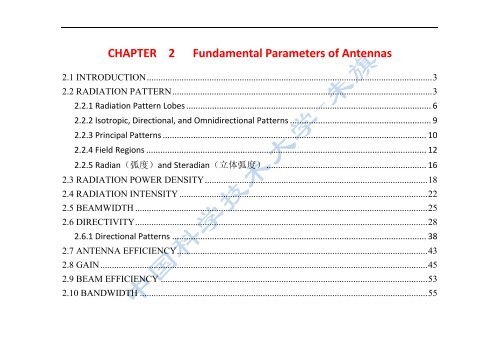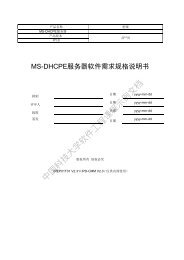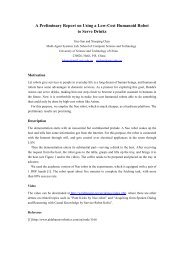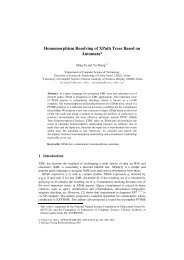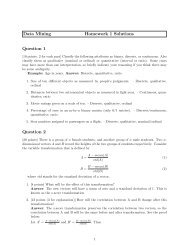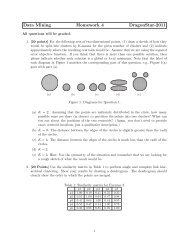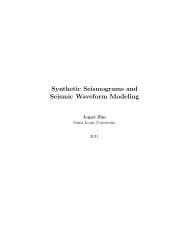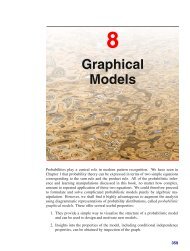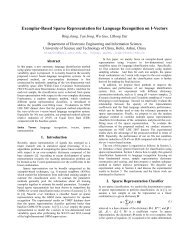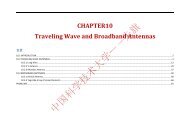CHAPTER 2 Fundamental Parameters of Antennas
CHAPTER 2 Fundamental Parameters of Antennas
CHAPTER 2 Fundamental Parameters of Antennas
You also want an ePaper? Increase the reach of your titles
YUMPU automatically turns print PDFs into web optimized ePapers that Google loves.
<strong>CHAPTER</strong><br />
2 <strong>Fundamental</strong> <strong>Parameters</strong> <strong>of</strong> <strong>Antennas</strong><br />
2.1 INTRODUCTION ........................................................................................................................... 3<br />
2.2 RADIATION PATTERN ................................................................................................................ 3<br />
2.2.1 Radiation Pattern Lobes ........................................................................................................ 6<br />
2.2.2 Isotropic, Directional, and Omnidirectional Patterns ............................................................ 9<br />
2.2.3 Principal Patterns ................................................................................................................ 10<br />
2.2.4 Field Regions ....................................................................................................................... 12<br />
2.2.5 Radian( 弧 度 )and Steradian( 立 体 弧 度 ).................................................................... 16<br />
2.3 RADIATION POWER DENSITY ................................................................................................ 18<br />
2.4 RADIATION INTENSITY ........................................................................................................... 22<br />
2.5 BEAMWIDTH .............................................................................................................................. 25<br />
2.6 DIRECTIVITY .............................................................................................................................. 28<br />
2.6.1 Directional Patterns ............................................................................................................ 38<br />
2.7 ANTENNA EFFICIENCY ............................................................................................................ 43<br />
2.8 GAIN ............................................................................................................................................. 45<br />
2.9 BEAM EFFICIENCY ................................................................................................................... 53<br />
2.10 BANDWIDTH ............................................................................................................................ 55
2.11 POLARIZATION ........................................................................................................................ 57<br />
2.11.1 Linear, Circular, and Elliptical Polarizations ....................................................................... 61<br />
2.11.2 Polarization Loss Factor and Efficiency .............................................................................. 68<br />
2.12 INPUT IMPEDANCE ................................................................................................................. 75<br />
2.14 ANTENNA RADIATION EFFICIENCY ................................................................................... 79<br />
2.15 ANTENNA VECTOR EFFECTIVE LENGTH AND EQUIVALENT AREAS ........................ 82<br />
2.15.1 Vector Effective Length ..................................................................................................... 83<br />
2.15.2 Antenna Equivalent Areas .................................................................................................. 87<br />
2.16 MAXIMUM DIRECTIVITY AND MAXIMUM EFFECTIVE AREA ..................................... 94<br />
2.17 FRIIS TRANSMISSION EQUATION AND RADAR RANGE EQUATION .......................... 97<br />
2.17.1 Friis Transmission Equation ............................................................................................... 97<br />
2.17.2 Radar Range Equation ..................................................................................................... 101<br />
2.17.3 Antenna Radar Cross Section .......................................................................................... 108<br />
Problems ............................................................................................................................................ 110
2.1 INTRODUCTION<br />
are necessary.<br />
2.2 RADIATION PATTERN<br />
as “a mathematical functionn or a graphical<br />
representa<br />
ation <strong>of</strong> the radiation properties <strong>of</strong><br />
the<br />
To describe the<br />
performance <strong>of</strong> an antenna, definitions <strong>of</strong> various parameters<br />
An antenna radiation pattern is defined<br />
antenna<br />
as<br />
coordinate<br />
es.” In most cases, the radiation<br />
pattern is determined in the far field region.<br />
Radiation properties include power flux<br />
density, radiation intensity, field strength,<br />
directivity<br />
, phase or<br />
polarization.”<br />
• Amplitude field pattern.<br />
• Amplitude power<br />
pattern.<br />
a<br />
function<br />
<strong>of</strong><br />
space
Often<br />
the field<br />
and power patterns are normalized<br />
to the maximum<br />
value,<br />
yielding normalized<br />
field and<br />
power patterns. The pattern is usually plotted on a<br />
logarithmic scale ( dB). This scale is desirablee becausee a logarithmic scale can<br />
accentuat<br />
e in more details those parts <strong>of</strong> the pattern <strong>of</strong> very low values.
• Field pattern typically represents a plot <strong>of</strong> the magnitude <strong>of</strong> the electric or<br />
magnetic field as a function <strong>of</strong> the angular space.<br />
• Power pattern typically represents a plot <strong>of</strong> the square <strong>of</strong> the magnitude <strong>of</strong> the<br />
electric or magnetic field as a function <strong>of</strong> the angular space.<br />
• Power pattern (in dB) represents the magnitude <strong>of</strong> the electric or magnetic field,<br />
in decibels, as a function <strong>of</strong> the angular space.
2.2.1 Radiation<br />
Pattern<br />
Lobes<br />
Various parts <strong>of</strong> a radiation pattern are referred to<br />
as lobes:major or<br />
main,<br />
minor, side, and back lobes.<br />
Figure 2.3(a) demonstrates a symmetrical three dimensional polar pattern<br />
with a number <strong>of</strong> radiation lobes.
Some<br />
are <strong>of</strong> greater radiation intensity than others, but all are classified as<br />
lobes. Figure 2.3(b) illustrates a linear two‐dimensional<br />
pattern where the<br />
same<br />
pattern characteristics are indicated.<br />
• A major lobe (main beam, 主 瓣 ) is definedd as “the radiation lobe containing<br />
the direction <strong>of</strong> maximum radiation.”<br />
In Figure 2.3 the major lobe is pointing in<br />
the θ = 0 direction. In some<br />
antennas, such as split‐beam antennas, there may<br />
exist more<br />
than one major lobe.<br />
• A minor lobe ( 旁 瓣 ) is any<br />
lobe except a major lobe.
• A side lobe( 副 瓣 ) is “a radiation lobe in any direction other than the<br />
intended lobe.” Usually a side lobe is adjacent to the main lobe<br />
• A back lobe is “a radiation lobe whose axis makes an angle <strong>of</strong> approximately<br />
180 o with respect to the beam <strong>of</strong> an antenna.”<br />
Minor lobes usually represent radiation in undesired directions and should<br />
be minimized. Side lobes are the largest minor lobes.
2.2.2 Isotropic, Directional, and Omnidirectional Patterns<br />
• An isotropic radiator is defined as “a hypothetical lossless antenna having<br />
equal radiation in all directions.” Although it is ideal and not physically<br />
realizable, it is <strong>of</strong>ten taken as a reference for expressing the directive properties<br />
<strong>of</strong> actual antennas.<br />
• A directional antenna is one having the property <strong>of</strong> radiating or receiving<br />
electromagnetic waves more effectively in some directions than in others.<br />
• An omnidirectional antenna is defined as one “having an essentially<br />
nondirectional pattern in a given plane and a directional pattern in any<br />
orthogonal plane. An omnidirectional pattern is then a special type <strong>of</strong> a<br />
directional pattern.
2.2.3 Principal<br />
Patterns<br />
For a linearly polarized<br />
antenna, performance is <strong>of</strong>ten described in terms<br />
<strong>of</strong> its principal E‐ and H‐plane patterns.<br />
• The E‐plane is defined as<br />
“the plane<br />
containing the electric field vector<br />
and the direction <strong>of</strong> maximum<br />
radiation.”<br />
• The H‐plane is defined as “the<br />
plane containing the magnetic‐field<br />
vector<br />
and the direction<br />
<strong>of</strong><br />
maximum radiation.”
An illustration<br />
is shown in Figure 2.5. For this example, the x‐z plane<br />
(elevation<br />
plane; = 0) is the principal E‐plane and the x‐y plane (azimuthal<br />
plane; θ= = /2) is the principal H‐plane. Other coordinate orientations can be<br />
selected.<br />
The omnidirectional pattern <strong>of</strong> Figure 2.6 has an infinite number <strong>of</strong><br />
principal<br />
E‐planes<br />
(elevation planes; = c ) and one principal H‐plane<br />
(azimutha<br />
al plane; θ= 90 o ).
2.2.4 Field Regions<br />
The space surrounding<br />
an antenna is usually subdivided into three regions:<br />
reactive near‐field,<br />
radiating near‐field (Fresnel 菲 涅 耳 ) region and far‐field<br />
(Fraunh<strong>of</strong>er 夫 琅 和 费 ) regions<br />
1. Reactive near‐fielmost antennas,<br />
the outer<br />
boundary<br />
<strong>of</strong> this<br />
region<br />
is <br />
region<br />
For<br />
0.62 /, is the wavelength and D<br />
is the largest dimension <strong>of</strong> the antenna.<br />
a. The reactive field predominates<br />
b. For a very short dipole,<br />
or<br />
equivalent<br />
radiator,<br />
the outer<br />
boundary is commonly<br />
taken to<br />
/2.
2. Radiating near‐field (Fresnel) region<br />
Defined as “that region <strong>of</strong> the field <strong>of</strong> an antenna between the reactive<br />
near‐field<br />
region and the far‐field region<br />
a. Radiation fields<br />
predominate<br />
b. The angular field distribution<br />
is dependent<br />
upon the<br />
distance from the antenna.<br />
c. If the antenna has a maximum<br />
overall dimension which is<br />
very small compared to<br />
the<br />
wavelength, this field region<br />
may not exist.<br />
The region is limited by<br />
0.62 / 2<br />
/.
3. Far‐field (Fraunh<strong>of</strong>er) region<br />
a. The angular field<br />
distribution is essentially<br />
the antenna.<br />
independent <strong>of</strong> the distance from<br />
b. The far‐field region is taken to exist at distances greater than 2 /<br />
from<br />
the antenna.<br />
As the observation is<br />
moved to the radiating<br />
near‐field<br />
region, the<br />
pattern begins to smooth<br />
and form<br />
lobes. In the<br />
far‐field region, the<br />
pattern is well formed,<br />
usually consisting<br />
<strong>of</strong> few<br />
minor lobes and one, or<br />
more, major lobes.
Figure<br />
parabolic<br />
2.9 shows three patterns<br />
<strong>of</strong> a<br />
reflectorr calculated at distances<br />
<strong>of</strong> R 2D /,4D<br />
/, and<br />
infinity.<br />
It is observed<br />
that the patterns are<br />
almost<br />
identical,<br />
except<br />
for some<br />
difference<br />
es in the pattern structure around<br />
the first null and at a level below 25 dB.<br />
Because<br />
infinite distances<br />
are<br />
not<br />
realizable<br />
e in practice, the most commonly<br />
used criterion for<br />
minimum distance <strong>of</strong><br />
far‐field observations is 2<br />
/.
2.2.5 Radian( 弧 度 )and Steradian(<br />
( 立 体 弧 度 )<br />
The measure <strong>of</strong> a solid<br />
angle is a steradian.<br />
One steradian<br />
is defined as the solid<br />
angle with<br />
its vertex at the center <strong>of</strong> a sphere<br />
<strong>of</strong> radius that is<br />
subtended by a spherical<br />
surface area .<br />
Since<br />
the areaa <strong>of</strong> a sphere <strong>of</strong> radius is<br />
4 , there are 4 sr<br />
4 /<br />
in a<br />
closed sphere.<br />
The infinitesimal area <br />
surface <strong>of</strong><br />
a spheree is given by<br />
on the<br />
<br />
<br />
(m 2 )<br />
(2‐1)<br />
Therefore<br />
e, the solid<br />
angle d can be<br />
written as<br />
/ (sr)<br />
(2‐2)
Example 2.1<br />
For a sphere <strong>of</strong> radius r, find the solid angle (in square radians or steradians)<br />
<strong>of</strong> a spherical cap on the surface sphere over the north‐pole region defined by<br />
spherical angles <strong>of</strong> 0 30 o , 0 360 o . Do this<br />
a. exactly.<br />
b. using A 1 2 , where 1 and 2 are two perpendicular angular<br />
separations <strong>of</strong> the spherical cap passing through the north pole.<br />
Compare the two.<br />
Solution:<br />
a. Using (2‐2), we can write that<br />
<br />
Ω Ω<br />
<br />
<br />
<br />
/<br />
<br />
b. Ω ΔΘ ∙ΔΘ | <br />
∙ 1.09662<br />
The approximate beam solid angle is about 31.23% in error.<br />
<br />
<br />
<br />
0.83566
2.3 RADIATION POWER DENSITY<br />
Instantaneous Poynting vector is a power density and is used to describe<br />
the power associated with an electromagnetic wave<br />
(2‐3)<br />
:instantaneous Poynting vector (W/m 2 )<br />
: instantaneous electric field intensity (V/m)<br />
: instantaneous magnetic field intensity (A/m)<br />
The total power, crossing a closed surface, can be obtained by integrating the<br />
normal component <strong>of</strong> the Poynting vector over the entire surface<br />
∯<br />
<br />
∙<br />
∯<br />
<br />
∙<br />
P: instantaneous total power (W);<br />
n: unit vector normal to the surface<br />
da: infinitesimal area <strong>of</strong> the closed surface m <br />
(2‐4)
For time varying fields, average power density is needed, which is obtained<br />
by integrating the instantaneous Poynting vector over one period and dividing<br />
by the period. For the form <br />
, , ; , , ;<br />
, , ; , , 2‐5, 6<br />
Using the definitions <strong>of</strong> (2‐5) and (2‐6) and the identity<br />
Re, , , , /2<br />
(2‐3) can be written as<br />
(2‐3) ∗ (2‐7)<br />
<br />
Finally, the time average Poynting vector (average power density) is<br />
, , , , ; ∗ /2 (W/m 2 ) (2‐8)<br />
Note:<br />
• The real part <strong>of</strong> ∗ /2 represents the average (real) power density<br />
• The imaginary part represents the reactive (stored) power density
The 1/2 factor appears in (2‐7) and (2‐8) because the and fields<br />
represent peak values, and it should be omitted for RMS values<br />
Based upon the definition <strong>of</strong> (2‐8), the average power radiated power can<br />
be written as<br />
∙<br />
<br />
∯<br />
<br />
∙<br />
∯<br />
<br />
Re ∗ ∙<br />
(2‐9)
Example 2.1<br />
The radial component <strong>of</strong> the radiated power density <strong>of</strong> an antenna is<br />
<br />
<br />
(W/m2 )<br />
is the peak value <strong>of</strong> the power density, is the spherical coordinate,<br />
and is the radial unit vector. Determine the total radiated power.<br />
SOLUTION<br />
For a closed surface, a sphere <strong>of</strong> radius is chosen. To find the<br />
total‐radiated power, the radial component <strong>of</strong> the power density is<br />
integrated over its surface.<br />
∙<br />
<br />
<br />
<br />
<br />
<br />
<br />
∙
2.4 RADIATION INTENSITY<br />
Radiation intensity in a given direction is defined as "the power radiated<br />
from an antenna per unit solid angle."<br />
The radiation intensity is a far‐field parameter, and it can be obtained by<br />
multiplying the radiation density by the square <strong>of</strong> the distance.<br />
(2‐12)<br />
Where<br />
=radiation intensity (W/unit solid angle);<br />
=radiation density (W/m 2 )<br />
The radiation intensity is also related to the far‐zone electric field <strong>of</strong> an<br />
antenna by<br />
Where<br />
, <br />
2 , , <br />
2 | , , | , , <br />
<br />
| , | | , | (2‐12a)
, , : far‐zone electric field intensity <strong>of</strong> the antenna , <br />
E , E : far‐zone electric field components <strong>of</strong> the antenna<br />
η : intrinsic impedance <strong>of</strong> the medium<br />
Thus the power pattern is also a measure <strong>of</strong> the radiation intensity.<br />
The total power is obtained by integrating the radiation intensity, as given<br />
by (2‐12), over the entire solid angle <strong>of</strong> 4. Thus<br />
<br />
<br />
<br />
<br />
Ω<br />
<br />
<br />
Comparison: ∯<br />
<br />
<br />
<br />
<br />
<br />
<br />
∙<br />
<br />
(2‐13)
Example 2.2<br />
For Example 2.I, find the total radiated power using (2‐13).<br />
SOLUTION<br />
Using (2‐12) and by (2‐13)<br />
<br />
<br />
<br />
<br />
<br />
<br />
<br />
<br />
<br />
<br />
<br />
<br />
<br />
For an isotropic source, will be independent <strong>of</strong> the angles and ,<br />
as was the case for . Thus (2‐13) can be written as<br />
∯<br />
<br />
Ω<br />
∯<br />
<br />
Ω<br />
or the radiation intensity <strong>of</strong> an isotropic source as<br />
4 (2‐14)<br />
/4 (2‐15)
2.5 BEAMWIDTH<br />
The beamwidth<br />
<strong>of</strong> a pattern is defined: the<br />
angular separation between two<br />
identical points on opposite side <strong>of</strong> the pattern<br />
maximum.<br />
1. Half‐Power Beamwidth (HPBW).<br />
2. First‐Null Beamwidth (FNBW).<br />
• Often,<br />
the term<br />
beamwidt<br />
th<br />
HPBW.<br />
usually<br />
refers<br />
to<br />
• The<br />
beamwidth<br />
is a<br />
trade‐<strong>of</strong>f<br />
between<br />
it and the side<br />
lobe<br />
level.<br />
The<br />
beamwidth<br />
decreases<br />
s, the side lobe increases<br />
and vice versa.<br />
• The beamwidth <strong>of</strong> the antenna is also<br />
used to<br />
describee the resolution<br />
capabilitie<br />
es to distinguish two adjacent radiating sources or targets.
The most common resolution criterion is FNBW/2, which is usually used to<br />
approximate HPBW.<br />
That is, two sources separated by angular distances equal or greater than<br />
FNBW/2 ≈ HPBW <strong>of</strong> an antenna can be resolved.<br />
If the separation is smaller, then the antenna will tend to smooth the<br />
angular separation distance.<br />
Example 2.4<br />
The normalized radiation intensity <strong>of</strong> an antenna is represented by<br />
Uθ cos θcos 3θ,0θ90 ,0 ϕ360 <br />
Find the<br />
a. half‐power beamwidth HPBW (in radians and degrees)<br />
b. first‐null beamwidth FNBW (in radians and degrees)<br />
Solution:
a. Since the represents the power pattern, to find the half‐power<br />
beamwidth. Let<br />
Uθ| 3| 0.5⟹θ cos 3θ 0.707<br />
⟹ θ 0.25 rad 14.325 0<br />
Since is symmetrical about the maximum at 0, then the HPBW is<br />
HPBW 2θ 0.5 rad 28.65 <br />
b. To find the first‐null beamwidth (FNBW), let the equal to zero<br />
Uθ| cos θcos 3θ| 0<br />
This leads to two solutions for θ <br />
θ 2 90 , θ 6<br />
30<br />
The one with the smallest value leads to the FNBW. Again, because <strong>of</strong> the<br />
symmetry <strong>of</strong> the pattern, the FNBW is<br />
FNBW 2θ π 3<br />
radians 60
2.6 DIRECTIVITY<br />
• The directivity <strong>of</strong> an antenna defined as the ratio <strong>of</strong> the radiation intensity in<br />
a given direction from the antenna to the radiation intensity averaged over<br />
all directions.<br />
• The average radiation intensity is equal to the total power radiated by the<br />
antenna divided by 4.<br />
If the directionis not specified, the direction <strong>of</strong> maximum radiation intensity<br />
is implied. Directivity can be written as<br />
D <br />
, <br />
| <br />
<br />
<br />
D = directivity (dimensionless); D 0 = maximum directivity (dimensionless)<br />
U = radiation intensity (W/unit solid angle);<br />
= total radiated power (W)<br />
= maximum radiation intensity (W/unit solid angle);<br />
= radiation intensity <strong>of</strong> isotropic source (W/unit solid angle);
For antennas with orthogonal polarization components, define the partial<br />
directivity <strong>of</strong> an antenna for a given polarization in a given direction as:<br />
Partial directivity<br />
Part <strong>of</strong> the radiation intensity with a given polarization in a given direction<br />
<br />
the total radiation intensity averaged over all directions<br />
So, in a given direction “the total directivity is the sum <strong>of</strong> the partial directivities<br />
for any two orthogonal polarizations.” For a spherical coordinate system, the<br />
total maximum directivity for the orthogonal and components <strong>of</strong> an<br />
antenna can be written as<br />
<br />
while the partial directivities and are expressed as<br />
where<br />
<br />
<br />
<br />
, <br />
<br />
<br />
= radiationin tensity in a given direction contained in field component<br />
= radiationin tensity ina givendirectioncon tained in field component
Example 2.5<br />
= radiated power in all directions contained in field component<br />
= radiated power in all directions contained in field component<br />
Find the maximum directivity <strong>of</strong> the antenna whose radiation intensity is<br />
that <strong>of</strong> Example 2.2. Write an expression for the directivity as a function <strong>of</strong> the<br />
directional angles and .<br />
Solution:<br />
The radiation intensity is given by<br />
<br />
The maximum radiation is directed along: /2<br />
Thus <br />
In Example 2.2 it was found that<br />
P π A <br />
We find that the maximum directivity is equal to
4 <br />
<br />
4 1.27<br />
Since the radiation intensity is only a function <strong>of</strong> , the directivity as a<br />
function <strong>of</strong> the directional angles is represented by<br />
Example 2.6<br />
1.27<br />
The radial component <strong>of</strong> the radiated power density <strong>of</strong> an infinitesimal<br />
linear dipole <strong>of</strong> length l
The radiation intensity is given by<br />
2 <br />
The maximum radiation is directed along /2. Thus<br />
<br />
The total radiated power is given by<br />
<br />
Ω <br />
<br />
<br />
Using (2‐16a), the maximum directivity is equal to<br />
8 /3<br />
4 <br />
<br />
4 <br />
8 /3 1.5<br />
greater than 1.27 in Example 2.5. Thus the directivity is represented by<br />
1.5 <br />
Figure 2.12 shows the relative radiation intensities <strong>of</strong> Example 2.5<br />
(U A sin) and Example 2.6 (U A sin )
a. Both patterns are omnidirectional<br />
b. Example 2.6 has more<br />
directional characteristics (is narrower) in the<br />
elevation plane.
Another example:<br />
approxim<br />
ated by<br />
Examine the directivity <strong>of</strong> a half‐wavelength dipole,<br />
1.67 <br />
which<br />
(2.18)<br />
The values represented by (2‐18) and<br />
those <strong>of</strong> an isotropic source ( <br />
in Figure 2.13(a, b) .<br />
1) are
• It is apparent that when sin 1/1.67 / 57.44 θ 122.56 , the<br />
dipole radiator has greater directivity than that <strong>of</strong> an isotropic source.<br />
• Outside the range, the isotropic radiator has higher directivity. The maximum<br />
directivity <strong>of</strong> the dipole is 1.67 2.23 /2.<br />
• The directivity <strong>of</strong> an isotropic source is unity<br />
• For all other sources, the maximum directivity will be greater than unity.<br />
• The directivity can be smaller than unity: in fact it can be equal to zero. For<br />
Examples 2.3 and 2.4, the directivity is equal to zero in the 0 direction.<br />
A more general expression for the directivity can be developed to include<br />
sources with radiation patterns that may be functions <strong>of</strong> both spherical<br />
coordinate angles and .<br />
Let the radiation intensity <strong>of</strong> an antenna be <strong>of</strong> the form<br />
, , <br />
| , | | , | 2‐19
where is a constant, and and are the antenna's far‐zone electric<br />
field components. The maximum value <strong>of</strong> (2‐19) is given by<br />
, | , (2‐19a)<br />
The total radiated power is found using<br />
<br />
∯ , <br />
<br />
, 2‐20<br />
<br />
We now write the general expression for the directivity and maximum<br />
directivity using (2‐16) and (2‐16a), respectively, as<br />
Dθ, ϕ <br />
<br />
<br />
<br />
<br />
,<br />
,<br />
Equation (2‐22) can also be written as<br />
D <br />
, D <br />
<br />
<br />
<br />
<br />
<br />
<br />
,<br />
<br />
,| <br />
,| <br />
<br />
<br />
,<br />
<br />
<br />
2‐21, 22<br />
2‐23<br />
where Ω is the beam solid angle, and it is given by
1<br />
<br />
<br />
, | <br />
<br />
<br />
<br />
<br />
<br />
, <br />
<br />
, <br />
2‐24<br />
<br />
, <br />
,<br />
,| <br />
(2‐25)<br />
Dividing by , | merely normalizes the radiation intensity<br />
, , and it makes its maximum value unity.<br />
The beam solid angle Ω is defined as the solid angle through which all<br />
the power <strong>of</strong> the antenna would flow if its radiation intensity is constant (and<br />
equal to the maximum value <strong>of</strong> U) for all angles within Ω .
2.6.1 Directional Patterns<br />
Instead <strong>of</strong> using (2‐23) to compute the directivity,<br />
derive simpler expressions approxima<br />
ately.<br />
it is <strong>of</strong>ten convenient to<br />
For antennas<br />
with one<br />
narrow<br />
major lobe and very negligible<br />
minor lobes, the beam solid angle is<br />
approxim<br />
ately equal to the product<br />
<strong>of</strong> the half‐power<br />
beamwidths in<br />
two perpendicular<br />
planes.<br />
For a rotationally symmetric<br />
pattern,<br />
the half‐power<br />
beamwidt<br />
ths in<br />
any two<br />
perpendic<br />
cular planes are the same,<br />
as illustrated in Figure 2.14( b).<br />
(a)Nonsymmetrical pattern (b) Symmetrica<br />
l pattern<br />
Figure 2.14 Beam solid angles for nonsymmetrical<br />
and symmetrical radiation patterns.
With this approximation, (2‐23) can be approximated by<br />
D <br />
<br />
<br />
,<br />
<br />
<br />
,| <br />
<br />
<br />
<br />
<br />
<br />
The beam solid angle Ω has been approximated by<br />
2‐23<br />
<br />
<br />
(2‐26)<br />
Ω Θ Θ (2‐26a)<br />
Where<br />
= half‐power beamwidth in one plane, (rad)<br />
= half‐power beamwidth in a plane at a right angle to the other, (rad)<br />
If the beamwidths are known in degrees, (2‐26) can be written as<br />
/<br />
<br />
,<br />
<br />
(2‐27)<br />
where<br />
1d = half‐power beamwidth in one plane (degrees)<br />
2d =half‐power beamwidth in a plane at a right angle to the other (degrees)
The validity <strong>of</strong> (2‐26) and (2‐27) is based on a pattern that has only one<br />
major lobe and any minor lobes.<br />
• For a pattern with two identical major lobes, the value <strong>of</strong> the maximum<br />
directivity using (2‐26) or (2‐27) will be twice its actual value.<br />
• For patterns with significant minor lobes, the values <strong>of</strong> maximum<br />
directivity obtained using (2‐26) or (2‐27), which neglect any minor<br />
lobes, will usually be too high.
Example<br />
2.7<br />
antennas<br />
can be adequately<br />
represented by<br />
where is the maximumm radiation intensity. The<br />
radiation<br />
intensity exists only in the upper hemispheree<br />
(0 /2, 0 2) ), and it is shown in the<br />
Figure. Find the<br />
a. beam solid angle; exact and approximate.<br />
b. maximum directivity; exact using (2‐23) and<br />
approximate using<br />
(2‐26).<br />
Solution:<br />
The<br />
radiation<br />
intensity<br />
<strong>of</strong> the major lobe<br />
<strong>of</strong> many<br />
beamwidt<br />
th in the<br />
ϕ coordinate,<br />
<br />
<br />
The half‐power point <strong>of</strong> the pattern occurs at 60 . Thus the<br />
direction is 120 . Since the pattern is independent<br />
<strong>of</strong> the<br />
<br />
Θ , Θ ,
a. Beam solid angle Ω <br />
<br />
<br />
/<br />
<br />
<br />
<br />
π steradians (2‐24)<br />
Approximate: Using (2‐26a)<br />
b. Directivity :<br />
4.386 steradians (2‐26)<br />
Exact: <br />
<br />
410log 4 6.02dB<br />
Approximate: <br />
<br />
<br />
<br />
<br />
2.865 4.57
2.7 ANTENNA<br />
EFFICIENCY<br />
Associated with an antenna are a number <strong>of</strong><br />
efficiencies. The total<br />
antenna<br />
efficiency is<br />
used to take<br />
into account losses at the<br />
input terminals<br />
and within the structure<br />
<strong>of</strong> the antenna.<br />
Such losses may be due to<br />
1. Reflections because <strong>of</strong> the mismatch<br />
between the transmission line and the<br />
antenna<br />
2. losses (conductionn and dielectric)<br />
The overall efficiency<br />
can be written<br />
as<br />
<br />
(2‐44)
where<br />
total efficiency (dimensionless)<br />
reflection(mismatch) efficiency = 1 || (dimensionless)<br />
= conduction efficiency (dimensionless)<br />
= dielectric efficiency (dimensionless)<br />
= voltage reflection coefficient at the input terminals <strong>of</strong> the antenna<br />
Where<br />
Z Z /Z Z <br />
Z = antenna input impedance,<br />
Z = characteristic impedance <strong>of</strong> the transmission line<br />
Usually and are very difficult to compute, but they can be<br />
determined experimentally.
2.8 GAIN<br />
The gain <strong>of</strong> the antenna is closely related to the directivity, it is a<br />
measure that takes into account the efficiency <strong>of</strong> the antenna as well as<br />
its directional capabilities.<br />
Directivity is a measure that describes only the directional<br />
properties <strong>of</strong> the antenna, and it is controlled only by the pattern.<br />
Absolute gain <strong>of</strong> an antenna is defined as "the ratio <strong>of</strong> the intensity,<br />
in a given direction, to the radiation intensity that would be obtained if<br />
the power accepted by the antenna were radiated isotropically. The<br />
isotropically radiated power is equal to the power accepted by the<br />
antenna divided by 4."<br />
gain 4π<br />
<br />
4π, <br />
(dimensionless)<br />
(2‐44)
Relative gain is defined as "the ratio <strong>of</strong> the power gain in a given<br />
direction to the power gain <strong>of</strong> a reference antenna in its referenced<br />
direction." The power input must be the same for both antennas.<br />
The reference antenna is usually a dipole, horn, or any other<br />
antenna whose gain can be calculated or it is known. In case the<br />
reference antenna is a lossless isotropic source. Then<br />
4<br />
,<br />
<br />
(dimensionless) (2‐44a)<br />
When the direction is not stated, the power gain is usually taken in<br />
the direction <strong>of</strong> maximum radiation.<br />
Referring to Figure 2.17(a), we can write that the total radiated<br />
power (P ) is related to the total input power (P ) by<br />
(2‐45)
According to the IEEE Standards, "gain does not include<br />
losses arising from impedance mismatches (reflection losses)<br />
and polarization mismatches (losses)."<br />
Both are very important losses and need to be included in the link<br />
calculations <strong>of</strong> a communication system to determine the received or<br />
radiated power.<br />
Using (2‐45) reduces (2‐44a) to<br />
, <br />
,<br />
<br />
(2‐46)<br />
which is related to the directivity <strong>of</strong> (2‐21) by<br />
, , (2‐47)<br />
In a similar manner, the maximum value <strong>of</strong> the gain is related to the<br />
maximum directivity by
G Gθ, ϕ| e Dθ, ϕ| e D (2‐47a)<br />
The partial gain <strong>of</strong> an antenna for a given polarization in a given<br />
direction is "that part <strong>of</strong> the radiation intensity corresponding to a given<br />
polarization divided by the total radiation intensity that would be<br />
obtained if the power accepted by the antenna were radiated<br />
isotropically." The total gain in a given direction is the sum <strong>of</strong> the partial<br />
gains for any two orthogonal polarizations.<br />
For a spherical coordinate system, the total maximum gain for<br />
the orthogonal and components <strong>of</strong> an antenna can be written as<br />
(2‐48)<br />
while the partial gains and are expressed as<br />
where<br />
4 / , 4 / (2‐48a)
U = radiation intensity in a given direction contained in field component<br />
U = radiation intensity in a given direction contained in field component<br />
P in = total input (accepted) power<br />
For many practical antennas an approximate formula for the gain,<br />
corresponding to (2‐27) or (2‐27a) for the directivity, is<br />
,<br />
(2‐49)<br />
<br />
Usually the gain is given in terms <strong>of</strong> decibels instead <strong>of</strong> the<br />
dimensionless quantity <strong>of</strong> (2‐47a). The conversion formula is given by<br />
G dB 10 log e D dimensionless (2‐50)
Example 2.8<br />
A lossless resonant half‐wavelength dipole antenna, with input impedance<br />
<strong>of</strong> 73 ohms, is to be connected to a transmission line whose characteristic<br />
impedance is 50 ohms. Assuming that the pattern <strong>of</strong> the antenna is given<br />
approximately by , find the overall maximum gain <strong>of</strong> this antenna.<br />
SOLUTION<br />
Let us first compute the maximum directivity <strong>of</strong> the antenna. For this<br />
| <br />
<br />
<br />
P Uθ, ϕsinθdθdϕ 2πB θsinθdθ 3π B /4<br />
<br />
<br />
4 <br />
16<br />
P rad 3π 1.697<br />
Since the antenna was lossless, then the radiation efficiency<br />
= 1<br />
Thus, the total maximum gain, as defined in this edition and by IEEE, is equal to
G D 11.697 1.697<br />
G dB 10 log 1.697 2.297<br />
which is identical to the directivity because the antenna is lossless.<br />
There is the loss due to reflection or mismatch losses between the antenna<br />
(load) and the transmission line. This loss is accounted for by the reflection<br />
efficiency <strong>of</strong> (2‐51) or (2‐52), and it is equal to<br />
Thus, the overall efficiency is<br />
1|| 1 Z <br />
Z <br />
0.965<br />
Z Z <br />
10 log 0.965 0.155 (dB)<br />
0.965<br />
0.155 dB<br />
Thus, the overall losses are equal to 0.155 dB.<br />
The gain in dB can also be obtained by converting the directivity and<br />
radiation efficiency in dB and then adding them. Thus,
dB 10 log 1.0 0<br />
D dB 10 log 1.697 2.297<br />
G dB dB D dB 2.297<br />
which is the same as obtained previously.
2.9 BEAM EFFICIENCY<br />
Beam<br />
efficiency is frequently used to judge the quality <strong>of</strong><br />
transmitt<br />
ting and receiving antennas. For an antenna with its major lobe<br />
directed<br />
along the z‐axis ( = 0), the beam efficiency (BE) is<br />
definedd by<br />
BE <br />
<br />
<br />
<br />
(2‐53)<br />
(dimensionless)<br />
is the<br />
half‐angle <strong>of</strong> the cone<br />
within which the<br />
percenta<br />
age <strong>of</strong> the<br />
total power is to<br />
be found.<br />
Equation (2‐53) can be<br />
written<br />
as<br />
BE <br />
<br />
<br />
<br />
<br />
<br />
<br />
<br />
<br />
<br />
,<br />
,<br />
(2‐54)
If is chosen as the angle where the first null or minimum occurs<br />
(see Figure 2.4), then the beam efficiency will indicate the amount <strong>of</strong><br />
power in the major lobe compared to the total power.<br />
A very high beam efficiency is necessary for antennas used in<br />
radiometry, astronomy, radar, and other applications where received<br />
signals through the minor lobes must be minimized.
2.10 BANDWIDTH<br />
The bandwidth <strong>of</strong> an antenna is defined as "the range <strong>of</strong> frequencies<br />
within which the performance <strong>of</strong> the antenna, with respect to some<br />
characteristic, conforms to a specified standard."<br />
The bandwidth can be considered to be the range <strong>of</strong> frequencies, on<br />
either side <strong>of</strong> a center frequency, where the antenna characteristics<br />
(such as input impedance, pattern, beamwidth, polarization, side lobe<br />
level, gain, beam direction, radiation efficiency) are within an acceptable<br />
value <strong>of</strong> those at the center frequency.<br />
• The bandwidth is usually expressed as the ratio <strong>of</strong> the<br />
upper‐to‐lower frequencies <strong>of</strong> acceptable operation. For example,<br />
a 10 : 1 bandwidth indicates that the upper frequency is 10 times<br />
greater than the lower.
• For narrowband antennas, the bandwidth is expressed as a<br />
percentage <strong>of</strong> the frequency difference (upper minus lower) over<br />
the center frequency <strong>of</strong> the bandwidth. For example, a 5%<br />
bandwidth indicates that the frequency difference <strong>of</strong> acceptable<br />
operation is 5% <strong>of</strong> the center frequency <strong>of</strong> the bandwidth.
2.11 POLARIZATION<br />
Polarization <strong>of</strong> an antenna in a given direction is defined as "the<br />
polarization <strong>of</strong> the wave transmitted (radiated) by the antenna.<br />
Polarization <strong>of</strong> a wave is defined as "that property <strong>of</strong> an<br />
electromagnetic wave describing the time varying direction and relative<br />
magnitude <strong>of</strong> the electric‐field vector "<br />
• When the direction is not stated, the polarization is taken to be the<br />
polarization in the direction <strong>of</strong> maximum gain."<br />
• Polarization <strong>of</strong> the radiated energy varies with the direction from the<br />
center <strong>of</strong> the antenna, so that different parts <strong>of</strong> the pattern may have<br />
different polarizations.<br />
Polarization is the curve traced by the end point <strong>of</strong> the arrow<br />
representing the instantaneous electric field. A typical trace as a<br />
function <strong>of</strong> time is shown in Figures 2.18(a) and (b).
Figure 2.18<br />
Rotation <strong>of</strong> a plane electromagnetic wave and its polarization ellipse at z = 0 as a function <strong>of</strong> time.<br />
Polarizat<br />
ion may be classified as<br />
1. Elliptical<br />
The figure that the electric field traces<br />
is an ellipse.<br />
Linear and circular polarizations are special cases <strong>of</strong> elliptical
2. Linear<br />
If the vector that describes the electric field at a point in space as a<br />
function <strong>of</strong> time is always directed along a line, the field is said to be<br />
linearly polarized.<br />
• Vertical polarization<br />
• horizontal polarization<br />
3. Circular<br />
The figure <strong>of</strong> the electric field is traced in a<br />
Clockwise (CW): the electric field vector is right‐hand polarization<br />
Counterclockwise (CCW): the electric field vector is left‐hand<br />
polarization.
4. Co‐polarization and cross polarization<br />
At each point on the radiation sphere the polarization is usually<br />
resolved into a pair <strong>of</strong> orthogonal polarizations, the co‐polarization and<br />
cross polarization. Co‐polarization represents the polarization the<br />
antenna is intended to radiate (receive) while cross‐polarization<br />
represents the polarization orthogonal to the co‐polarization.<br />
2.11.1 Linear, Circular, and Elliptical Polarizations<br />
The instantaneous field <strong>of</strong> a plane wave, traveling in the negative z<br />
direction, can be written as<br />
, , , (2‐55)<br />
According to (2‐5), the instantaneous components are related to their<br />
complex counterparts by<br />
, ωt+kz) ωt+kz+)
ωt+kz+ ) (2‐56)<br />
, ωt+kz) ωt+kz+) <br />
ωt+kz+ ) (2‐57)<br />
where and are, respectively, the maximum magnitudes <strong>of</strong> the<br />
x and y components.<br />
A. Linear Polarization<br />
For the wave to have linear polarization, the time‐phase difference<br />
between the two components must be<br />
<br />
<br />
n, 0, 1, 2, 3, … (2‐58)<br />
Which means that the phases <strong>of</strong> z, t and z, t are the same or<br />
reverse.<br />
B. Circular Polarization<br />
Circular polarization can be achieved only when
• the magnitudes <strong>of</strong> the two components are the same<br />
• the time‐phase difference between them is odd multiples <strong>of</strong> /2.<br />
That is,<br />
| | E E (2‐59)<br />
<br />
<br />
2n π, n 0, 1, ,2, … for CW (2‐60)<br />
<br />
<br />
<br />
2n π, n 0, 1, ,2, … for CCW (2‐61)<br />
<br />
If the direction <strong>of</strong> wave propagation is reversed (i.e., +z direction), the<br />
phases in (2‐60) and (2‐61) for CW and CCW rotation must be<br />
interchanged.<br />
C. Elliptical Polarization<br />
Elliptical polarization can be attained only when<br />
• the time‐phase difference between the two components is odd
multiples <strong>of</strong> /2 and their magnitudes are not the same<br />
• or, when the time‐phase difference between the two components is<br />
not equal to multiples <strong>of</strong> /2 (irrespective <strong>of</strong> their magnitudes). That<br />
is,<br />
When<br />
| | E E <br />
<br />
<br />
2n π, n 0, 1, ,2, … for CW 2‐62a<br />
Or<br />
<br />
<br />
2n π, n 0, 1, ,2, … for CCW 2‐62b<br />
<br />
<br />
π 0, 0, 1, ,2, … 2‐63<br />
<br />
<br />
π 0, 0, 1, ,2, … 2‐64
For elliptical polarization, the curve<br />
traced at<br />
a given<br />
position<br />
as a function <strong>of</strong><br />
time is a tilted ellipse, as<br />
shown in Figure<br />
2.18(b). The ratio<br />
<strong>of</strong> the major axis to the<br />
minor axis is the axial ratio (AR),<br />
<br />
AR <br />
,1AR 2‐65<br />
<br />
where<br />
OA E <br />
<br />
E <br />
E <br />
E <br />
2E <br />
E cos 2Δϕ /<br />
/ 2‐66<br />
OB<br />
E <br />
E <br />
<br />
E <br />
E <br />
2E<br />
E cos<br />
2Δϕ / / / 2‐67<br />
The tilt <strong>of</strong> the ellipse, relative to the y axis, is represented τ given by<br />
<br />
τ tan <br />
<br />
cos 2ϕ<br />
2‐68
SUMMARY<br />
1. Linear Polarization<br />
A time‐harmonic wave is linearly polarized at a given point in space if the<br />
electric field (or magnetic field) vector at that point is always oriented along the<br />
same straight line at every instant <strong>of</strong> time. This is accomplished if the field<br />
vector (electric or magnetic) possesses:<br />
a. Only one component, or<br />
b. Two orthogonal linear components that are in time phase or 180 o (or<br />
multiples <strong>of</strong> 180 o ) out <strong>of</strong> phase.<br />
2. Circular Polarization<br />
A time‐harmonic wave is circularly polarized at a given point if the electric<br />
(or magnetic) field vector at that point traces a circle as a function <strong>of</strong> time. The<br />
necessary and sufficient conditions to accomplish this are:<br />
a. The field must have two orthogonal linear components, and<br />
b. The two components must have the same magnitude, and
c. The two components must have a time‐phase difference <strong>of</strong> odd multiples<br />
<strong>of</strong> 90 o .<br />
3. Elliptical Polarization<br />
A wave is elliptically polarized if it is not linearly or circularly polarized.<br />
Although linear and circular polarizations are special cases <strong>of</strong> elliptical, usually<br />
in practice elliptical polarization refers to other than linear or circular. The<br />
necessary and sufficient conditions to accomplish this are if the field vector<br />
(electric or magnetic) possesses all <strong>of</strong> the following:<br />
a. The field must have two orthogonal linear components, and<br />
b. The two components can be <strong>of</strong> the same or different magnitude.<br />
c. (1) If the two components are not <strong>of</strong> the same magnitude, the time‐phase<br />
difference between the two components must not be 0 or multiples <strong>of</strong><br />
180 (because it will then be linear). (2) If the two components are <strong>of</strong> the<br />
same magnitude, the time‐phase difference between the two components<br />
must not be odd multiples <strong>of</strong> 90 o (because it will then be circular).
2.11.2 Polarization Loss Factor and Efficiency<br />
The polarization <strong>of</strong> the receiving antenna will not be the same as the<br />
<strong>of</strong> the incident wave. This is stated as "polarization mismatch." The<br />
amount <strong>of</strong> power extracted by the antenna from the incident signal will<br />
not be maximum because <strong>of</strong> the polarization loss. Assuming the electric<br />
field <strong>of</strong> the incident wave is<br />
E ρ E <br />
2‐69<br />
where ρ is the unit vector <strong>of</strong> the wave. Assuming the polarization <strong>of</strong><br />
the electric field <strong>of</strong> the receiving antenna is<br />
E ρ E <br />
2‐70<br />
where ρ is its unit vector (polarization vector). The polarization loss<br />
factor (PLF) is defined<br />
PLF |ρ ∙ρ | cos|ψ | dimensionless 2‐71
where ψ is the angle<br />
between the two unit polarization <strong>of</strong> the<br />
incoming<br />
wave and <strong>of</strong> the<br />
vectors shown in Figure 2.19.<br />
If the<br />
antennaa is polarization<br />
matched,<br />
its PLF 1 and<br />
the antenna will extract<br />
maximum<br />
m power from the<br />
incoming wave.<br />
Another figure‐<strong>of</strong>‐merit describing the<br />
polarizat<br />
ion characteristics <strong>of</strong> a wave and<br />
that <strong>of</strong> an antenna is the polarization<br />
efficiency<br />
y.<br />
Polarization efficiency<br />
is defined as:<br />
Figure 2.19 Polarization<br />
unit<br />
vectors<br />
<strong>of</strong> incident wave (ρ ρ ) and<br />
antenna (ρ )<br />
"The<br />
ratio <strong>of</strong><br />
the power received by an antenna from<br />
a given plane<br />
wave <strong>of</strong> arbitrary<br />
polarization to the power that would be received by<br />
the same<br />
antenna from a plane wave <strong>of</strong> the same power flux density and
direction <strong>of</strong> propagation, whose polarization has been adjusted for a<br />
maximum received power."<br />
| ∙ | <br />
| | ∙| | <br />
Where<br />
2‐71a = vector effective length <strong>of</strong> the antenna<br />
= incident electric field<br />
The vector effective length is a vector that describes the<br />
polarization characteristics <strong>of</strong> the antenna. Both the PLF and lead to<br />
the same answers.
Example 2.9<br />
The electric field <strong>of</strong> a linearly polarized electromagnetic wave given by<br />
, <br />
is incident upon a linearly polarized antenna whose electric field polarization<br />
can be expressed as<br />
, , <br />
Find the polarization loss factor (PLF)<br />
SOLUTION<br />
For the incident wave and the antenna<br />
, √<br />
<br />
The PLF is:<br />
PLF | ∙ | | ∙ √<br />
| 10 log<br />
<br />
0.5 3dB<br />
1. Even the incoming wave and the antenna are linearly polarized, there is a<br />
3‐dB loss in extracted power because the polarization <strong>of</strong> the incoming wave is
not aligned with<br />
the polarization <strong>of</strong> the antenna.<br />
2. If the<br />
polarization <strong>of</strong> the incoming wave is<br />
orthogonal to the<br />
polarization <strong>of</strong><br />
the antenna,<br />
then there will be<br />
no power extracted by the antenna from<br />
the incoming<br />
wave and<br />
the PLF will be zero or ‐ dB.<br />
In Figures 2.20(a, b) we<br />
illustrate<br />
the polarization loss factors (PLF) <strong>of</strong><br />
two<br />
types <strong>of</strong> antennas;<br />
wires and<br />
apertures.<br />
(a) PLF for transmitting and receiving aperture antennas
(b) PLF for transmitting and receiving<br />
linear wire<br />
antennas<br />
Figure 2.25 Polarization loss factors (PLF) for aperture and linear wire antennas.<br />
The polarization loss must always be taken into account in the link<br />
calculatio<br />
ns design<br />
<strong>of</strong> a communication system<br />
becausee in some cases it may be<br />
a very critical factor.<br />
Link calculations <strong>of</strong> communication systems for outer space explorations<br />
are very stringent because <strong>of</strong> limitations in spacecraft weight. In such cases,<br />
power is a limiting consideration. The<br />
design must properly take into account all<br />
loss factors to ensure a successful operation <strong>of</strong><br />
the system.
An antenna that is elliptically polarized is<br />
composed <strong>of</strong> two crossed dipoles,<br />
as shown in Figure<br />
2.26. The two crossed dipoles provide the two orthogonal<br />
field components.<br />
Figure 2.26 Geometry <strong>of</strong> elliptically polarized cross‐dipole antenna.<br />
If the two dipoles are<br />
identical, the field intensity <strong>of</strong> each along zenith<br />
(perpendi<br />
icular to the plane <strong>of</strong> the two dipoles) would be <strong>of</strong> the<br />
same intensity.<br />
Also, if the two dipoles were fed with a 90◦ degree time‐phasee difference, the<br />
polarizatio<br />
on along zenith would be circular and<br />
elliptical.
2.12 INPUT IMPEDANCE<br />
Input impedance is defined as "the impedance presented<br />
at an antenna’s<br />
terminals<br />
or the ratio <strong>of</strong> the<br />
voltage to current<br />
at a pair<br />
<strong>of</strong> terminals or the ratio<br />
<strong>of</strong> the appropriate<br />
components <strong>of</strong> the<br />
electric to magnetic fields at a point."<br />
Input impedance at the input<br />
terminals<br />
<strong>of</strong> the antenna is<br />
primarily<br />
interestin<br />
g. In Figure 2.27(a) the<br />
terminals<br />
are designated as a‐b. The<br />
ratio <strong>of</strong> the voltage to current at the<br />
terminals,<br />
with no load attached,<br />
defines<br />
the impedance<br />
<strong>of</strong> the<br />
antenna as<br />
where<br />
<br />
Z A = antenna impedance at terminals a‐b (ohms)<br />
R A = antenna resistance at terminals a‐b (ohms)<br />
(2‐72)
X A = antenna reactance at terminals<br />
a‐b (ohms)<br />
Assume the antenna is attached<br />
to a generator<br />
with internal impedance<br />
<br />
<br />
2‐74<br />
where<br />
R = resistancee <strong>of</strong> generator impedance ( ohms)<br />
X = reactance<br />
e <strong>of</strong> generator impedance ( ohms)<br />
Being used in the transmitting mode, the antenna<br />
and generator can be represent by Figure 2.27(b).<br />
To find the amount <strong>of</strong> power delivered to for radiation and the<br />
amount dissipated<br />
in as<br />
heat ( /2), we first find the current developed<br />
within the<br />
loop which is given by<br />
<br />
<br />
<br />
A 2‐75
and its magnitude by | |<br />
where is the peak generator voltage.<br />
| |<br />
| | /<br />
2‐75a<br />
• The power delivered to the antenna for radiation is given by<br />
| <br />
| | | | <br />
<br />
W 2‐76<br />
<br />
• and that dissipated as heat in antenna by<br />
| <br />
| | | | <br />
<br />
W 2‐77<br />
<br />
• The power dissipated as heat on the internal resistance R g <strong>of</strong> the generator is<br />
| | <br />
<br />
W 2‐78<br />
<br />
The maximum power delivered to the antenna occurs when conjugate<br />
matching is achieved<br />
For this case<br />
; 2‐79, 20‐80
| | <br />
<br />
| | <br />
<br />
2‐81<br />
| | <br />
<br />
2‐82<br />
<br />
| | <br />
<br />
| | <br />
<br />
| | <br />
2‐83<br />
<br />
From (2‐81)‐(2‐83), it is clear that<br />
<br />
<br />
<br />
<br />
2‐84<br />
<br />
The power supplied by the generator during conjugate matching is<br />
<br />
<br />
<br />
<br />
<br />
W 2‐85
2.14 ANTENNA RADIATION EFFICIENCY<br />
The conduction‐dielectric efficiency e is defined as the ratio <strong>of</strong> the<br />
power delivered to the radiation resistance , to the power delivered to<br />
. The radiation efficiency can be written as<br />
<br />
dimensionless 2‐90<br />
<br />
For a metal rod <strong>of</strong> length and area , the dc resistance is given by<br />
<br />
<br />
<br />
ohms 2‐90a<br />
If the skin depth 2/ <strong>of</strong> the metal is very small compared to<br />
the smallest diagonal <strong>of</strong> the cross section <strong>of</strong> the rod, the current is confined to a<br />
thin layer near the conductor surface. Therefore the high‐frequency resistance<br />
can be written, based on a uniform current distribution, as<br />
<br />
<br />
ohms 2‐90b<br />
Where
2 is the perimeter <strong>of</strong> the cross section <strong>of</strong> the rod (: the radius <strong>of</strong> wire)<br />
is the conductor surface resistance<br />
is the angular frequency<br />
<br />
is the free‐space’s permeability<br />
is the metal’s conductivity.<br />
Example 2.13<br />
A resonant half‐wavelength dipole is made out <strong>of</strong> copper ( 5.710 s/m)<br />
wire. Determine the conduction‐dielectric (radiation) efficiency <strong>of</strong> the dipole<br />
antenna at 100 MHz, the radius <strong>of</strong> the wire b is 310 , and the<br />
radiation resistance <strong>of</strong> the /2 dipole is 73 ohms.<br />
SOLUTION<br />
At 10 Hz<br />
<br />
3; 3/2;<br />
<br />
<br />
2 2310 610
For a /2 dipole with a sinusoidal current distribution R L where<br />
is given by (2‐90b). Therefore,<br />
e <br />
1 2 <br />
0.25 4 10 <br />
6 10 10 5.7 10 0.349 <br />
<br />
. 0.9952 99.52; e dB 10log 0.9952 0.02
2.15 ANTENNA<br />
VECTOR<br />
EFFECTIVE LENGTH<br />
AND EQUIVALENT<br />
AREAS<br />
An antenna in the receiving<br />
mode, whatever its form, is used to<br />
capture (collect)<br />
electromagnetic<br />
waves and to extract power from<br />
them,<br />
as shown<br />
in Figures 2.29( a) and (b).<br />
For each antenna, its<br />
equivalent length and equivalent areas can be<br />
defined to describe the receiving<br />
characteristics <strong>of</strong> an antenna, when a<br />
wave is incident upon the<br />
antenna.
2.15.1 Vector Effective Length<br />
The effective length <strong>of</strong> an antenna is a quantity to determine the voltage<br />
induced on the open‐circuit terminals <strong>of</strong> the antenna when a wave<br />
impinges upon it. It should be noted that it is also referred to as the<br />
effective height.<br />
The vector effective length for an antenna is a complex vector<br />
represented by<br />
, , , (2‐91)<br />
It is a far‐field quantity and it is related to the far‐zone field <br />
radiated by the antenna, with current in its terminals<br />
<br />
(2‐92)<br />
The effective length is particularly useful in relating the open‐circuit voltage<br />
<strong>of</strong> receiving antennas. This relation can be expressed as
where<br />
∙ (2‐93)<br />
= open‐circuit voltage at antenna terminals<br />
= incident electric field<br />
= vector effective length<br />
In (2‐93) can be thought <strong>of</strong> as the voltage induced in a linear antenna<br />
<strong>of</strong> length when and are linearly polarized.<br />
From the relation <strong>of</strong> (2‐93) the effective length <strong>of</strong> a linearly polarized<br />
antenna receiving a plane wave in a given direction is defined as<br />
The ratio <strong>of</strong> the magnitude <strong>of</strong> the open‐circuit voltage developed at the<br />
terminals <strong>of</strong> the antenna to the magnitude <strong>of</strong> the electric‐field strength in the<br />
direction <strong>of</strong> the antenna polarization.<br />
In addition, the antenna vector effective length is used to determine<br />
the polarization efficiency <strong>of</strong> the antenna.
Example 2.14<br />
The far‐zone field radiated by a small dipole <strong>of</strong> length <br />
and<br />
with a triangular current distribution is given by<br />
<br />
<br />
8<br />
Determine the vector effective length <strong>of</strong> the antenna.<br />
Solution: According to (2‐92), the vector effective length is<br />
<br />
<br />
(2‐92)<br />
<br />
⇒ <br />
2 <br />
• This indicates the effective length is a function <strong>of</strong> the direction angle .<br />
• The maximum open circuit voltage at the dipole terminals occurs when the<br />
incident direction <strong>of</strong> the wave is normal to the dipole ( 90 ).<br />
• In addition, the effective length <strong>of</strong> the dipole to produce the same output
open‐circuit voltage is only half (50%) <strong>of</strong> its physical length if it were replaced<br />
by a thin conductor having a uniform current distribution<br />
• The maximum effective length <strong>of</strong> an element with an ideal uniform current<br />
distribution is equal to its physical length.
2.15.2 Antenna Equivalent Areas<br />
• Antenna Equivalent Areas<br />
• The scattering area<br />
• The loss area<br />
• the capture area<br />
Antenna Equivalent Areas are used to describe the power<br />
capturing characteristics <strong>of</strong> antennas when wave imping on them, which<br />
in a given direction is defined as “the ratio <strong>of</strong> the available power at the<br />
terminals <strong>of</strong> a receiving antenna to the power flux density <strong>of</strong> a plane<br />
wave incident on the antenna from that direction, the wave being<br />
polarization‐matched to the antenna. If the direction is not specified, the<br />
direction <strong>of</strong> maximum radiation intensity is implied.”It is written as<br />
<br />
<br />
| | /<br />
<br />
(2‐94)<br />
Where = effective area (effective aperture) (m 2 );<br />
= power delivered to the load (W);<br />
= power density <strong>of</strong> incident wave (W/m 2 )
Using<br />
the equivalent <strong>of</strong> Figure<br />
can write (2‐94) as<br />
| |<br />
<br />
| <br />
| | /<br />
<br />
<br />
<br />
<br />
<br />
<br />
<br />
2.28, we<br />
(2‐94)<br />
(2‐95)<br />
Under conditions <strong>of</strong> maximumm power<br />
transferr (conjugate matching),<br />
and , the<br />
effective area <strong>of</strong> (2‐95) reduces to the<br />
maximum<br />
m effectivee aperturee given by<br />
|<br />
| <br />
<br />
| <br />
| <br />
<br />
When (2‐96) is multiplied by<br />
the incident power density, it leads<br />
power <strong>of</strong> (2‐89).<br />
<br />
<br />
(2‐96)<br />
to the captured
∗ <br />
<br />
∗<br />
| | <br />
<br />
<br />
(2‐97)<br />
All captured power by an antenna is not delivered to the load. In<br />
fact, under conjugate matching only half <strong>of</strong> the captured power is<br />
delivered to the load; the other half is scattered and dissipated as heat.<br />
To account for the scattered and dissipated power, in addition to the<br />
effective area, the scattering, loss and capture equivalent areas are<br />
defined.<br />
The scattering area is defined as the equivalent area when<br />
multiplied by the incident power density is equal to the scattered or<br />
reradiated power. Under conjugate matching this is written as<br />
A | | <br />
<br />
(2‐97)<br />
multiplied by the incident power density gives the scattering power.
The loss area is defined as the equivalent area, which when<br />
multiplied by the incident power density leads to the power dissipated<br />
as heat through . Under conjugate matching this is written as<br />
| | <br />
<br />
(2‐98)<br />
multiplied by the incident power density gives the dissipated power.<br />
The capture area is defined as the equivalent area, which when<br />
multiplied by the incident power density leads to the total power<br />
captured by the antenna. Under conjugate matching this is written as<br />
| | <br />
<br />
(2‐99)<br />
<br />
multiplied by the incident power density, it leads to the captured power.<br />
The total capture area is equal to the sum <strong>of</strong> the other three, or<br />
Capture Area Effective Area Scattering Area Loss Area
The aperture efficiency <strong>of</strong> an antenna, which is defined as the<br />
ratio <strong>of</strong> the maximum effective area A <strong>of</strong> the antenna to its physical<br />
area A , or<br />
<br />
<br />
<br />
<br />
<br />
(2‐100)<br />
• For aperture type antennas, such as waveguides, horns, and<br />
reflectors, the maximum effective area cannot exceed the physical area<br />
but it can equal it (A A or 0 1). Therefore the maximum<br />
value <strong>of</strong> the aperture efficiency cannot exceed unity (100%).<br />
• For a lossless antenna (R 0) the maximum value <strong>of</strong> the<br />
scattering area is also equal to the physical area. Therefore even though<br />
the aperture efficiency is greater than 50%, under conjugate matching<br />
only half <strong>of</strong> the captured power is delivered to the load and the other<br />
half is scattered.
Example 2.15<br />
A uniform plane<br />
wave is incident upon a very short lossless dipole (l
where<br />
V T = induced voltage on the dipole<br />
E = electric field <strong>of</strong> incident wave, l = length <strong>of</strong> dipole<br />
For a uniform plane wave, the incident power density can be written as<br />
/2<br />
where is the intrinsic impedance <strong>of</strong> the medium ( 120 ohms for a free‐space<br />
medium). Thus<br />
<br />
|| <br />
8 /280 / 0.119
2.16 MAXIMUM<br />
DIRECTIVITY AND MAXIMUMM EFFECTIVE AREA<br />
To derive the relationship<br />
between directivity and maximum<br />
effective<br />
effective<br />
area, let Antenna 1 be<br />
a transmitter<br />
and 2 a receiver. The<br />
areas and directivities<br />
<strong>of</strong> each are designated<br />
as , and<br />
, . If<br />
antenna 1 were isotropic, and the total radiated power. its<br />
radiated<br />
power density at<br />
a distance would be<br />
<br />
<br />
<br />
<br />
(2‐101)<br />
Because <strong>of</strong> the directive properties<br />
<strong>of</strong> the antenna, its actual density is<br />
<br />
<br />
<br />
<br />
(2‐102)<br />
The power collected (received) by the antenna and transferred to the<br />
load would be
⟹ <br />
<br />
4 (2‐103)<br />
If antenna 2 is used as a transmitter, 1 as a receiver, and the<br />
intervening medium is linear, passive, and isotropic, we can write that<br />
<br />
4 <br />
(2‐104)<br />
Equating (2‐103a) and (2‐104) reduces to<br />
<br />
<br />
<br />
<br />
(2‐105)<br />
Increasing the directivity <strong>of</strong> an antenna increases its effective area in<br />
direct proportion. Thus, (2‐105) can be written as<br />
<br />
<br />
<br />
<br />
(2‐106)<br />
where A and A (D and D ) are the maximum effective areas<br />
(directivities) <strong>of</strong> antennas 1 and 2, respectively. If antenna 1 is isotropic,
then D 1 and its maximum effective area can be expressed as<br />
<br />
(2‐107)<br />
<br />
For example, let the antenna be a very short dipole<br />
whose effective area = 0.119 and maximum directivity = 1.5. The<br />
maximum effective area <strong>of</strong> the isotropic source is then equal to<br />
<br />
.<br />
.<br />
Using (2‐108), we can write (2‐107) as<br />
<br />
<br />
<br />
<br />
<br />
(2‐108)<br />
(2‐109)<br />
In general then, the maximum effective aperture (A ) <strong>of</strong> any<br />
antenna is related to its maximum directivity (D ) by<br />
<br />
<br />
<br />
(2‐110)
2.17 FRIIS TRANSMISSION EQUATION AND RADAR RANGE<br />
EQUAT<br />
TION<br />
The analysiss and design <strong>of</strong><br />
radar and communications systems<br />
require the use <strong>of</strong> the Friis Transmission<br />
Equation<br />
and the<br />
Radar Range<br />
Equation<br />
n.<br />
2.17.1 Friis Transmission<br />
Equation<br />
The Friis Transmission Equation relates the power received to the<br />
power transmitted between two antennas separated by R <br />
, D is<br />
<br />
the largest dimension <strong>of</strong> either antenna.
Assuming the transmitting antenna is isotropic. If the input power at the<br />
terminals <strong>of</strong> the transmitting antenna is P , then its isotropic power<br />
density W at distance R from the antenna is<br />
<br />
W e <br />
<br />
2‐113<br />
<br />
e : the radiation efficiency <strong>of</strong> the transmitting antenna.<br />
For a nonisotropic transmitting antenna, the power density <strong>of</strong><br />
(2‐113) in the direction , is<br />
W , <br />
<br />
e <br />
, <br />
(2‐114)<br />
Since the effective area <strong>of</strong> the receiving antenna is related to its<br />
efficiency and directivity by<br />
<br />
<br />
; <br />
, <br />
<br />
the power collected by the receiving antenna is<br />
(2‐115)
P e D θ ,ϕ <br />
W <br />
<br />
e e , , <br />
|ρ<br />
<br />
∙ρ | <br />
The ratio <strong>of</strong> the received to the input power as<br />
(2‐118)<br />
<br />
<br />
, , <br />
(2‐117)<br />
<br />
The power received based on (2‐117) assumes that the transmitting<br />
and receiving antennas are matched to their respective lines or loads<br />
and the polarization <strong>of</strong> the receiving antenna is polarization‐matched to<br />
the impinging wave.<br />
If these two factors are also included, then the ratio <strong>of</strong> the received<br />
to the input power <strong>of</strong> (2‐117) is represented by<br />
<br />
<br />
<br />
, , 1 |Γ | 1 |Γ | |ρ ∙ρ | <br />
(2‐118)
For reflection and polarization‐matched antennas aligned for maximum<br />
directional radiation and reception, (2‐118) reduces to<br />
<br />
<br />
<br />
2‐119<br />
Equations (2‐117), (2‐118), or (2‐119) are known as the Friis<br />
Transmission Equation, and it relates the power (delivered to the<br />
receiver load) to the input power <strong>of</strong> the transmitting antenna . The<br />
term <br />
is called the free‐space loss factor, and it takes into<br />
account the losses due to the spherical spreading <strong>of</strong> the energy by the<br />
antenna.
2.17.2 Radar Range Equation<br />
Assuming that the transmitted power is incident upon a target, as<br />
shown in<br />
Figure 2.32.<br />
The radar cross section (RCS) or echo areaa ( ) <strong>of</strong> a target, is<br />
defined<br />
as the area intercepting<br />
that amount <strong>of</strong> power<br />
which, when<br />
scattered<br />
isotropically, produces at the receiver a density which is equal<br />
to that scattered<br />
by the actual target. In equation form
→ <br />
(2‐120)<br />
4 <br />
4 | | <br />
→ → | | <br />
→ 4 | | <br />
(2‐120a)<br />
= radar cross section or echo area (m 2 )<br />
R = observation distance from target (m)<br />
W = incident power density (W/m 2 )<br />
W = scattered power density (W/m 2 )<br />
E (E ) = incident (scattered) electric field (V/m)<br />
H H ) = incident (scattered) magnetic field (A/m)<br />
Using the definition <strong>of</strong> radar cross section, we can consider that<br />
• the transmitted power incident upon the target is initially<br />
captured;
• then it is reradiated isotropically, ins<strong>of</strong>ar as the receiver is<br />
concerned.<br />
The amount <strong>of</strong> captured power is obtained by multiplying the<br />
incident power density <strong>of</strong> (2‐114) by the radar cross section, or<br />
W , <br />
<br />
, <br />
<br />
<br />
e <br />
, <br />
(2‐114)<br />
, <br />
<br />
(2‐121)<br />
The power captured by the target is reradiated isotropically, and the<br />
scattered power density can be written as<br />
<br />
<br />
, <br />
(2‐122)<br />
<br />
The amount <strong>of</strong> power delivered to the receiver load is given by<br />
, , <br />
<br />
<br />
(2‐123)
Equation(2‐123) can be written as the ratio <strong>of</strong> the received power to the<br />
input power, or<br />
<br />
<br />
, , <br />
<br />
<br />
(2‐124)<br />
<br />
Expression (2‐124) is used to relate the received power to the input<br />
power, It does not include reflection losses and polarization losses. If<br />
these two losses are also included, then (2‐124) must be expressed as<br />
<br />
<br />
, , <br />
<br />
<br />
1 |Γ<br />
| 1 |Γ | |ρ ∙ρ | <br />
<br />
(2‐125)<br />
For polarization‐matched antennas aligned for maximum directional<br />
radiation and reception, (2‐125) reduces to<br />
<br />
<br />
<br />
<br />
2‐126<br />
<br />
Equation(2‐124 ), or (2‐125) or (2‐126) is known as the Radar Range
Equation. It relates the power P (delivered to the receiver load) to the<br />
input power P transmitted by an antenna, after it has been scattered<br />
by a target with a radar cross section (echo area) <strong>of</strong> .<br />
Example 2.16<br />
Two lossless X‐band 8.2– 12.4 GHz horn antennas are separated by a<br />
distance <strong>of</strong> 100 . The reflection coefficients at the terminals <strong>of</strong> the<br />
transmitting and receiving antennas are 0.1 and 0.2 , respectively. The<br />
maximum directivities <strong>of</strong> the transmitting and receiving antennas (over<br />
isotropic) are 16 dB and 20 dB, respectively. Assuming that the input power in<br />
the lossless transmission line connected to the transmitting antenna is 2W, and<br />
the antennas are aligned for maximum radiation between them and are<br />
polarization‐matched, find the power delivered to the load <strong>of</strong> the receiver.<br />
Solution:<br />
For this problem<br />
e e 1 because antennas are lossless.
|ρ ∙ρ | 1 because antennas are polarization‐matched<br />
D D ,D D because antennas are aligned for maximum<br />
radiation between them<br />
D 16 dB➱39.81 (dimensionless)<br />
D 20 dB➱100 (dimensionless)<br />
Using (2‐118), we can write<br />
<br />
211<br />
39.81 1001 0.1 1 0.2 1 =4.777mW
2.17.3 Antenna Radar Cross Section<br />
The radar cross section is a far‐field parameter, which is used to<br />
characterize the scattering properties <strong>of</strong> a radar target.<br />
• monostatic or backscattering RCS<br />
• bistatic RCS<br />
The RCS <strong>of</strong> a target is a function <strong>of</strong><br />
1. polarization <strong>of</strong> the incident wave,<br />
2. the angle <strong>of</strong> incidence,<br />
3. the angle <strong>of</strong> observation,<br />
4. the geometry <strong>of</strong> the target,<br />
5. the electrical properties <strong>of</strong> the target,<br />
6. the frequency <strong>of</strong> operation.<br />
The units <strong>of</strong> RCS <strong>of</strong> three‐dimensional targets are m 2 ,or dBsm, or RCS/ 2 in<br />
dB.<br />
The RCS <strong>of</strong> a target can be controlled using primarily two basic methods:
shaping and the use <strong>of</strong> materials.<br />
• Shaping is used to attempt to direct the scattered energy toward<br />
directions other than the desired. However, for many targets shaping has<br />
to be compromised in order to meet other requirements, such as<br />
aerodynamic specifications for flying targets.<br />
• Materials are used to trap the incident energy within the target and to<br />
dissipate part <strong>of</strong> the energy as heat or to direct it toward directions other<br />
than the desired.<br />
Usually both methods, shaping and materials, are used together in order to<br />
optimize the performance <strong>of</strong> a radar target.<br />
One <strong>of</strong> the“golden rules”to observe in order to achieve low RCS is to<br />
“round corners, avoid flat and concave surfaces, and use material treatment in<br />
flare spots.”
Problems<br />
2.4. Find the half-power beamwidth (HPBW) and first-null beamwidth (FNBW),<br />
in radians and degrees, for the following normalized radiation intensities:<br />
aUθ cosθ bUθ cos θ<br />
cUθ cos2θ dUθ cos 2θ<br />
eUθ cos3θ fUθ cos 3θ<br />
0 θ 90 ,0 φ 360 <br />
2.7. The power radiated by a lossless antenna is 10 watts. The directional<br />
characteristics <strong>of</strong> the antenna are represented by the radiation intensity <strong>of</strong><br />
aU B cos θ<br />
bU B cos θ<br />
(watts/unit solid angle) and (0 ≤ θ ≤ π/2, 0 ≤ φ ≤ 2π)<br />
For each, find the<br />
(a) maximum power density (in watts/square meter) at a distance <strong>of</strong> 1,000<br />
m(assume far-field distance). Specify the angle where this occurs.
(b) exact and approximate beam solid angle 2A.<br />
(c) directivity, exact and approximate, <strong>of</strong> the antenna (dimensionless and in dB).<br />
(d) gain, exact and approximate, <strong>of</strong> the antenna (dimensionless and in dB).<br />
2.8. You are an antenna engineer and you are asked to design a high<br />
directivity/gain antenna for a space-borne communication system operating at 10<br />
GHz. The specifications <strong>of</strong> the antenna are such that its pattern consists basically<br />
<strong>of</strong> one major lobe and, for simplicity, no minor lobes (if there are any minor<br />
lobes they are <strong>of</strong> such very low intensity and you can assume they are negligible<br />
/zero). Also it is desired that the patternis symmetrical in the azimuthal plane. In<br />
order to meet the desired objectives, the mainlobe <strong>of</strong> the patternshould have a<br />
half-power beamwidth <strong>of</strong> 10 degrees. Inorder to expedite the design, it is<br />
assumed that the major lobe <strong>of</strong> the normalized radiation intensity <strong>of</strong> the antenna<br />
is approximated by<br />
Uθ, φ cos θ<br />
and it exists only in the upper hemisphere (0 ≤ θ ≤ π/2, 0 ≤ φ ≤ 2π). Determine<br />
the:<br />
(a) Value <strong>of</strong> n (not necessarily an integer) to meet the specifications <strong>of</strong> the major<br />
lobe. Keep 5 significant figures in your calculations.
(b) Exact maximum directivity <strong>of</strong> the antenna (dimensionless and in dB).<br />
(c) Approximate maximum directivity <strong>of</strong> the antenna based on Kraus’ formula<br />
(dimensionless and in dB).<br />
(d) Approximate maximum directivity <strong>of</strong> the antenna based on Tai & Pereira’s<br />
formula (dimensionless and in dB).<br />
2.9. In target-search ground-mapping radars it is desirable to have echo power<br />
received from a target, <strong>of</strong> constant cross section, to be independent <strong>of</strong> its range.<br />
For one such application, the desirable radiation intensity <strong>of</strong> the antenna is given<br />
by<br />
o<br />
o<br />
1 0 <br />
20<br />
<br />
<br />
o o o o<br />
U , 0.342csc<br />
20 60 0 360<br />
<br />
o<br />
o<br />
0 60 <br />
180<br />
<br />
<br />
<br />
Find the directivity (in dB) using the exact formula.<br />
2.15. The radiation intensity <strong>of</strong> an antenna is given by
Uθ, φ cos θsin φ<br />
for 0≤θ≤π/2 an d 0≤φ≤2π(i.e., inthe upper half-space). It is zero in the lower<br />
half-space. Find the<br />
(a) exact directivity (dimensionless and in dB)<br />
(b) elevationplan e half-power beamwidth (in degrees)<br />
2.17. The maximum gain <strong>of</strong> a horn antenna is +20 dB, while the gain <strong>of</strong> its first<br />
sidelobe is −15 dB. What is the difference in gain between the maximum and<br />
first sidelobe:<br />
(a) in dB<br />
(b) as a ratio <strong>of</strong> the field intensities.<br />
2.34. A 300 MHz uniform plane wave, traveling along the x-axis in the negative<br />
x direction, whose electric field is given by<br />
r<br />
jkx<br />
E ˆ ˆ<br />
w<br />
E0 jay 3az<br />
e <br />
<br />
where Eo is a real constant, impinges upon a dipole antenna that is placed at the
originan<br />
d whose electric<br />
direction is givenby<br />
field radiated toward the x-axis in<br />
the positive x<br />
r<br />
E<br />
a<br />
<br />
E<br />
a<br />
aˆ<br />
y<br />
2aˆ<br />
where Ea is a real constant. Determin<br />
ne the following:<br />
(a) Polarization <strong>of</strong> the incident wave (including axial ratio and sense <strong>of</strong> rotation,<br />
if any). You must justify (state why ).<br />
(b) Polarization <strong>of</strong> the antenna (including axial<br />
ratio and<br />
sense <strong>of</strong><br />
rotation, if any).<br />
You must justify (state why ).<br />
(c) Polarization loss factor (dimensionless and in dB).<br />
z<br />
<br />
jkx<br />
e <br />
2.35. The<br />
electric<br />
field <strong>of</strong> a uniform<br />
plane wave traveling along<br />
the negative z
directionis given by<br />
ˆ ˆ 0<br />
E a ja E e <br />
i<br />
w x y<br />
and is incident upon a receiving antenna placed at the origin and whose radiated<br />
electric field, toward the incident wave, is given by<br />
jkr<br />
e<br />
E ˆ<br />
2 ˆ<br />
a<br />
ax ayE1<br />
r<br />
Determine the following:<br />
(a) Polarization<strong>of</strong> the incident wave, and why<br />
(b) Sense <strong>of</strong> rotation <strong>of</strong> the incident wave.<br />
(c) Polarization <strong>of</strong> the antenna, and why<br />
(d) Sense <strong>of</strong> rotation <strong>of</strong> the antenna polarization.<br />
(e) Losses (dimensionless and in dB) due to polarization mismatch between the<br />
incident wave and the antenna.<br />
jkz


